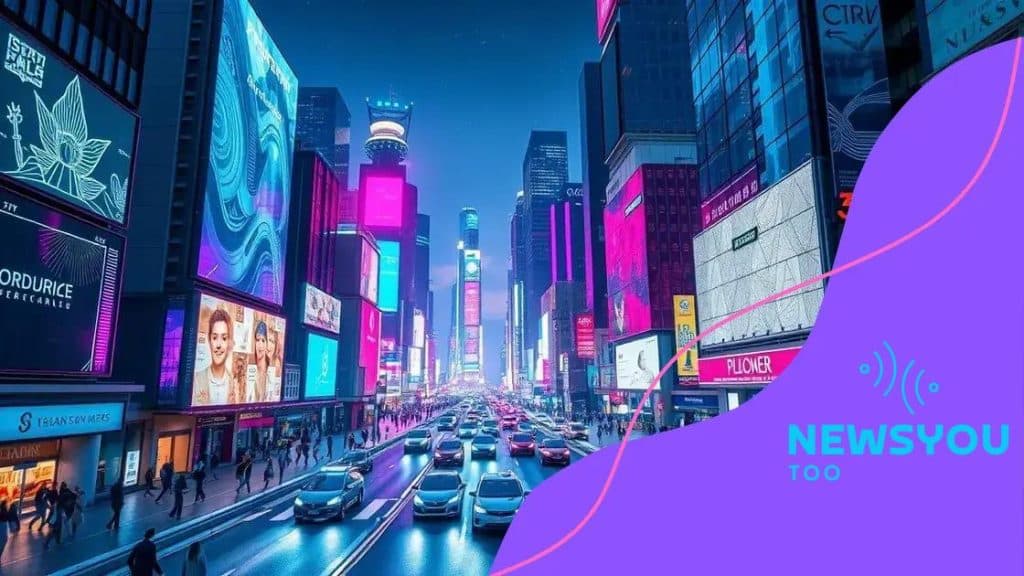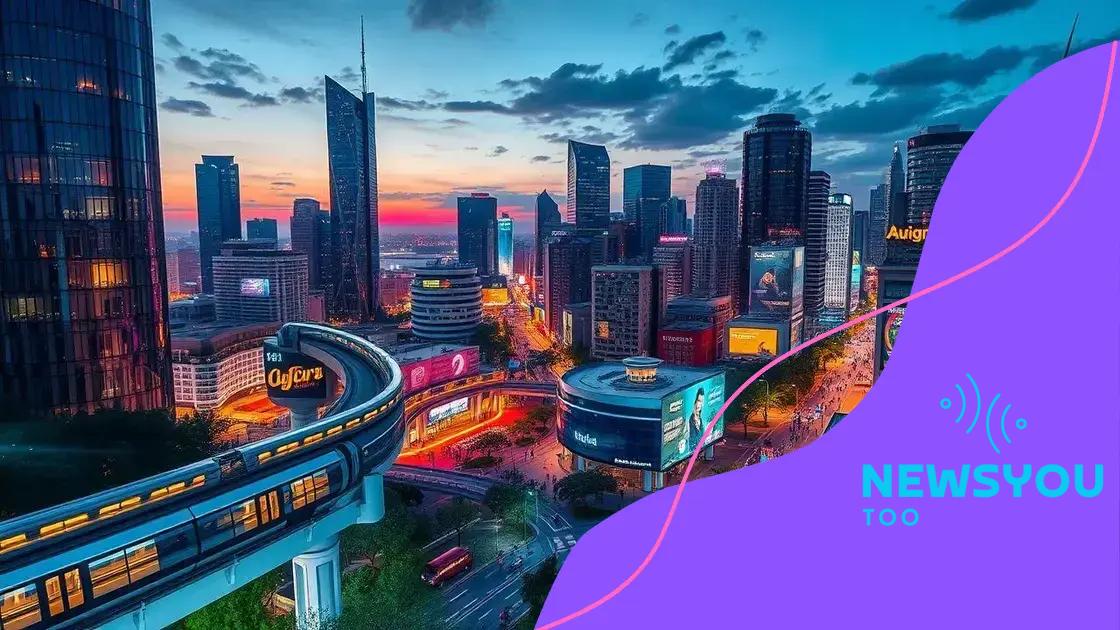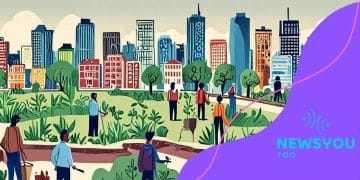The rise of smart cities and their impact on urban life

Anúncios
The rise of smart cities transforms urban life by integrating advanced technologies, enhancing sustainability, and fostering community engagement, resulting in safer, more efficient, and sustainable urban environments.
The rise of smart cities is changing urban living as we know it. Imagine walking through a city where technology seamlessly connects you to vital information and services, enhancing your daily experience. Curious about how this transformation impacts your life? Keep reading.
Anúncios
Understanding smart cities
Understanding smart cities is crucial as they redefine how we interact with our urban environments. These cities use technology to enhance the quality of life for their residents and improve city services. By incorporating intelligent systems, smart cities aim to create efficient, sustainable urban spaces.
What Makes a City Smart?
There are several components that contribute to a city’s smart status. Smart cities leverage technology to streamline operations, boost connectivity, and increase transparency. They utilize data analytics to monitor everything from traffic patterns to energy usage.
Key Features of Smart Cities
- Connected Infrastructure: Advanced sensors and IoT devices allow for real-time data collection.
- Efficient Public Services: Smart systems help optimize waste management, transportation, and energy distribution.
- Enhanced Mobility: Integration of smart transport solutions improves traffic flow and reduces congestion.
- Sustainable Practices: Emphasis on renewable energy and green spaces is vital for environmental health.
Moreover, the adoption of smart technologies opens the door for innovative solutions to urban challenges. From smart lighting systems that adjust based on usage to apps that provide real-time information on public transport, these advancements are progressively transforming our cities.
Anúncios
Engaging citizens in the development of smart cities is another essential aspect. Involving the community ensures that solutions address real needs and concerns, facilitating a more inclusive urban environment. This participatory approach fosters a sense of ownership among residents, leading to better outcomes.
Key technologies driving smart urbanization
Key technologies driving smart urbanization are essential for reshaping our cities. These innovations help streamline various urban processes, making life easier for residents. Understanding these technologies is crucial for anyone interested in the future of urban living.
Internet of Things (IoT)
The Internet of Things, or IoT, connects devices and sensors across the city. This technology allows for real-time data collection about traffic, weather, and energy use. As a result, city officials can make informed decisions quickly, improving services.
Big Data and Analytics
Utilizing big data is vital in smart cities. By analyzing vast amounts of information from various sources, cities can identify patterns and trends. This data helps in enhancing traffic management, waste disposal, and public safety.
- Real-time traffic analysis improves congestion.
- Predictive analytics help in resource allocation.
- Enhanced safety through crime pattern analysis.
Another vital technology is cloud computing. With cloud solutions, cities can store and process data efficiently. This technology enhances collaboration between different departments and makes data accessible to the public, fostering transparency.
Renewable energy technologies are also integral to smart urbanization. Cities are increasingly adopting solar panels, wind turbines, and other sustainable practices. This not only reduces carbon footprints but also lowers energy costs for residents.
Wireless communication technologies play a crucial role in connecting these smart devices. Technologies like 5G provide faster data transmission, enabling seamless communication between systems. This ensures that services are efficient and responsive.
As these technologies continue to evolve, the landscape of urban life will change significantly, making cities smarter, more efficient, and livable for everyone.
Benefits of living in a smart city

The benefits of living in a smart city are numerous and transformative for residents. These urban environments leverage technology to create safer, more efficient, and sustainable communities. By understanding these advantages, individuals can appreciate the value of smart city initiatives.
Improved Quality of Life
One of the most significant benefits is the overall quality of life. Smart cities offer innovative solutions that enhance daily experiences. With integrated public services, residents have easier access to information and resources, making life more convenient.
Enhanced Safety and Security
Another important aspect is enhanced safety. Smart technologies, like CCTV surveillance and emergency response systems, improve security. These features help to reduce crime rates, making communities safer for everyone.
- Smart streetlights that increase brightness in high-traffic areas.
- Real-time alerts for potential hazards, such as weather conditions.
- Increased community engagement through local safety initiatives.
Additionally, smart cities promote sustainability. By implementing renewable energy solutions and efficient waste management systems, they aim to reduce their carbon footprint. For example, solar-powered streetlights and smart recycling bins help conserve resources.
Another benefit is reduced traffic congestion. By utilizing smart traffic management systems, cities can optimize traffic flow, easing commute times. This technology also promotes alternatives like shared mobility services, encouraging residents to use public transport or carpool.
Smart connectivity is essential in enhancing the urban experience. With widespread internet access and connected devices, residents can engage with their environment like never before. Smart apps for public transport schedules or community events create a more connected and engaged population.
Challenges faced by smart city initiatives
Challenges faced by smart city initiatives can impact their development and success. While the benefits are clear, addressing these obstacles is vital for effective implementation and sustainability.
Funding and Budget Constraints
One significant challenge is securing adequate funding. Smart city projects often require substantial investment in technology and infrastructure. Limited budgets can hinder the progress of essential initiatives.
Data Privacy Concerns
Data privacy is another major issue. As smart cities rely on data collection, concerns about how this data is managed and protected grow. Residents may fear their personal information is at risk, leading to resistance against smart technology adoption.
- Ensuring transparency in data usage.
- Developing effective privacy policies.
- Building public trust through communication.
Technological integration also poses challenges. Many cities struggle to integrate new technologies with existing systems. Compatibility issues can delay projects and lead to inefficiencies.
Moreover, maintaining public engagement is crucial. Residents must be involved in discussions about smart city initiatives. Without community support, these projects may face backlash or lack effectiveness. Public outreach programs and workshops can help bridge this gap.
Finally, regulatory hurdles can obstruct development. Local governments often have strict regulations that can complicate the implementation of smart technologies. Navigating these rules requires time and resources that cities may not always have.
The future of urban life in smart cities
The future of urban life in smart cities promises to be a vibrant blend of technology, sustainability, and community involvement. As cities evolve, innovative solutions will significantly enhance daily living for residents.
Integration of Advanced Technologies
One key aspect is the constant integration of advanced technologies. In the coming years, residents can expect to interact with their environments through smarter devices, creating a more intuitive and efficient city experience.
Sustainable Practices
Another important element is sustainability. Future smart cities will prioritize green initiatives, such as renewable energy sources and energy-efficient buildings. These practices will lead to reduced environmental footprints, making cities cleaner and healthier.
- Enhanced public transport systems to reduce traffic congestion.
- Green spaces and urban gardens to improve air quality.
- Recycling and waste management systems utilizing smart technology.
The design of smart cities will also focus on community engagement. Residents will have a say in projects that affect them, fostering a sense of belonging and ownership. Technologies allowing for community feedback and participation will strengthen local governance.
Furthermore, with the rise of online platforms, accessing city services will become seamless. From reporting issues to applying for permits, interactions with city officials will be straightforward and user-friendly. Smart applications will streamline processes, reducing wait times and increasing efficiency.
As data-driven decision-making becomes the norm, city planners will develop policies based on real-time information. This ensures that urban management remains responsive to the needs of the residents. The future holds the potential for cities that can swiftly adapt to changes and challenges.
FAQ – Frequently Asked Questions about Smart Cities
What are smart cities?
Smart cities use technology and data to enhance urban living, improving the quality of life for residents through smart solutions.
How do smart cities promote sustainability?
They implement renewable energy, efficient public transport, and smart waste management systems to minimize environmental impact.
What role do residents play in smart city initiatives?
Residents are encouraged to participate in decision-making processes, helping shape projects that affect their communities.
What are some challenges faced by smart cities?
Common challenges include funding constraints, data privacy concerns, and the integration of new technologies with existing systems.





